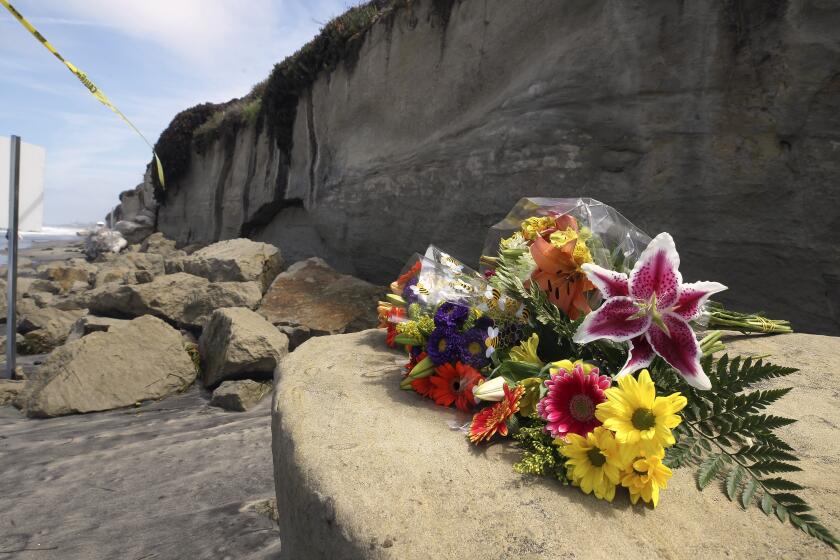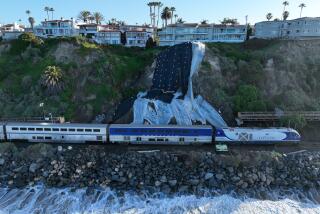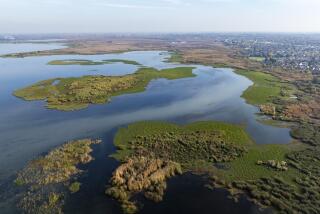Coastal Commission frowns on trenching idea for rail tracks atop oceanfront bluffs

A proposal to place the railroad tracks in a trench at the edge of the bluffs in Del Mar raises “serious concerns” about erosion and access to the beach, according to the California Coastal Commission.
“This new potential alternative ... would hamper efforts to plan for sea-level rise and erosion, thereby resulting in the loss of significant public access and beach resources,” said the commission’s Zach Rehm, a senior transportation program analyst, in a letter to the San Diego Assn. of Governments.
For the record:
1:20 p.m. Aug. 20, 2019An earlier version of this article said the cost of the proposed bluff trench was less than $400,000. It’s less than $400 million.
The bluff trench is one of several ideas being considered by the area’s regional planning agency to safeguard the tracks at the edge of the eroding coastline.
Landslides on the bluffs appear to have accelerated over the last year, leading state and regional agencies to step up their search for solutions. Other alternatives being considered by the regional planning agency include four possible routes that go as far as a mile inland and have tunnels up to 270 feet below ground, and a different trenched route that would follow Camino Del Mar beneath the pavement.
Cliff collapses like the one in Encinitas that killed three women are one of California’s many hidden dangers. We know what areas they’ll most likely happen – but nailing down when, and how big, is not an exact science.
“Rather than pursuing this [bluff trench] alternative, which would be in direct conflict with many Coastal Act policies ... Coastal staff instead encourages continued investment and development of the various tunnel options,” states the July 2 letter.
Most of the five-page Coastal Commission letter outlines reasons the staff is “delighted” with the announcement earlier this year by the regional planning agency’s executive director, Hasan Ikhrata, that the agency will focus its efforts on improving mass transit as a way to reduce greenhouse gases.
“We must present compelling alternatives to driving alone,” Rehm said, and improved rail service helps meet that goal.
Building a new inland rail route with tunnels would cost as much as $3.5 billion and require years of planning and design before construction could begin. Preliminary studies show the coastal trench alternative would cost less than $400 million and could be finished more quickly.
“That concept came up probably half a dozen years ago,” said Jim Linthicum, the planning agency’s director of mobility management.
“It was actually from one of our consultants,” he said. The San Diego Assn. of Governments “has not studied this at all. It’s an idea ... that our board wants us to study.... It doesn’t mean we are abandoning putting the tracks in a tunnel.”
The consultant suggested the trench could include pedestrian overpasses or even a park-like covering that would improve beach access, Linthicum said.
Slides and preliminary information presented at a recent North County Transit District board meeting show the trench would be up to 26 feet deep and 55 feet wide, with vertical walls and enough room for two sets of train tracks and a single-lane access road.
At present there’s no room for a second set of tracks at Del Mar, which could make that spot a bottleneck as trains become more frequent on San Diego County’s coastal rail corridor.
The regional planning agency and the transit district, which owns and operates the tracks, are working with other agencies to eventually double-track the entire 60-mile segment of railroad from the Orange County line to the Santa Fe Depot in downtown San Diego. About two-thirds of the route have been completed.
More to Read
Start your day right
Sign up for Essential California for news, features and recommendations from the L.A. Times and beyond in your inbox six days a week.
You may occasionally receive promotional content from the Los Angeles Times.








